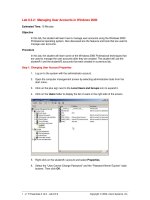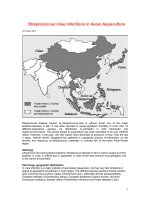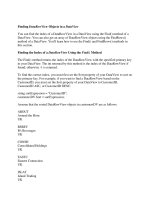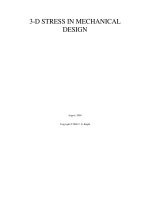Tài liệu 20 Robustness Issues in Adaptive Filtering docx
Bạn đang xem bản rút gọn của tài liệu. Xem và tải ngay bản đầy đủ của tài liệu tại đây (295.09 KB, 21 trang )
Sayed, A.H. & Rupp, M. “Robustness Issues in Adaptive Filtering”
Digital Signal Processing Handbook
Ed. Vijay K. Madisetti and Douglas B. Williams
Boca Raton: CRC Press LLC, 1999
c
1999byCRCPressLLC
20
Robustness Issues in Adaptive
Filtering
Ali H. Sayed
University of California, Los Angeles
Markus Rupp
Bell Laboratories
Lucent Technologies
20.1 Motivation and Example
20.2 Adaptive Filter Structure
20.3 Performance and Robustness Issues
20.4 Error and Energy Measures
20.5 Robust Adaptive Filtering
20.6 Energy Bounds and Passivity Relations
20.7 Min-Max Optimality of Adaptive Gradient Algorithms
20.8 Comparison of LMS and RLS Algorithms
20.9 Time-Domain Feedback Analysis
Time-DomainAnalysis
•
l
2
−
Stability andthe SmallGain Con-
dition
•
Energy Propagation in the Feedback Cascade
•
ADe-
terministic Convergence Analysis
20.10Filtered-Error Gradient Algorithms
20.11References and Concluding Remarks
Adaptive filters are systems that adjust themselves to a changing environment. They are designed
to meet certain performance specifications and are expected to perform reasonably well under the
operating conditions for which they have been designed. In practice, however, factors that may have
been ignored or overlooked in the design phase of the system can affect the performance of the
adaptive scheme that has been chosen for the system. Such factors include unmodeled dynamics,
modeling errors, measurement noise, and quantization errors, among others, and their effect on
the performance of an adaptive filter could be critical to the proposed application. Moreover, tech-
nological advancements in digital circuit and VLSI design have spurred an increase in the range of
new adaptive filtering applications in fields ranging from biomedical engineering to wireless com-
munications. For these new areas, it is increasingly important to design adaptive schemes that are
tolerant to unknown or nontraditional factors and effects. The aim of this chapter is to explore and
determine the robustness properties of some classical adaptive schemes. Our presentation is meant
as an introduction to these issues, and many of the relevant details of specific topics discussed in this
section, and alternative points of view, can be found in the references at the end of the chapter.
20.1 Motivation and Example
A classical application of adaptive filtering is that of system identification. The basic problem for-
mulation is depicted in Fig. 20.1,wherez
−1
denotes the unit-time delay operator. The diagram
contains two system blocks: one representing the unknown plant or system and the other containing
c
1999 by CRC Press LLC
FIGURE 20.1: A system identification example.
a time-variant tapped-delay-line or finite-impulse-response (FIR) filter structure. The unknown
plant represents an arbitrary relationship between its input and output. This block might implement
a pole-zero transfer function, an all-pole or autoregressive transfer function, a fixed or time-varying
FIR system, a nonlinear mapping, or some other complex system. In any case, it is desired to de-
termine an FIR model for the unknown system of a predetermined impulse response length M, and
whose coefficients at time i − 1 are denoted by{w
1,i−1
,w
2,i−1
,...,w
M,i−1
}. The unknown system
and the FIR filter are excited by the same input sequence{u(i)}, where the time origin is at i = 0.
IfwecollecttheFIRcoefficientsintoacolumnvector,sayw
i−1
= col{w
1,i−1
,w
2,i−1
,...,w
M,i−1
},
and define the state vector of the FIR model at time i as u
i
= col{u(i), u(i − 1),...,u(i− M + 1)},
then the output of the FIR filter at time i is the inner product u
T
i
w
i−1
. In principle, this inner product
should be compared with the output y(i)of the unknown plant in order to determine whether or not
the FIR output is a good enough approximation for the output of the plant and, therefore, whether
or not the current coefficient vector w
i−1
should be updated.
In general, however, we do not have direct access to the uncorrupted output y(i) of the plant but
rather to a noisy measurement of it, say d(i) = y(i) + v(i). The purpose of an adaptive scheme
is to employ the output error sequence {e(i) = d(i)− u
T
i
w
i−1
}, which measures how far d(i) is
from u
T
i
w
i−1
, in order to update the entries of w
i−1
and provide a better model, say w
i
, for the
unknown system. That is, the purpose of the adaptive filter is to employ the available data at time
i, {d(i),w
i−1
, u
i
}, in order to update the coefficient vector w
i−1
into a presumably better estimate
vector w
i
.
In this sense, we may regard the adaptive filter as a recursive estimator that tries to come up
with a coefficient vector w that “best” matches the observed data {d(i)} in the sense that, for all i,
d(i) ≈ u
T
i
w + v(i) to good accuracy. The successive w
i
provide estimates for the unknown and
desired w.
20.2 Adaptive Filter Structure
We may reformulate the above adaptive problem in mathematical terms as follows. Let {u
i
} be a
sequence of regression vectors and let w be an unknown column vector to be estimated or identified.
Given noisy measurements {d(i)} that are assumed to be related to u
T
i
w via an additive noise model
of the form
d(i)= u
T
i
w + v(i) ,
(20.1)
c
1999 by CRC Press LLC
we wish to employ the given data{d(i),u
i
} in order to provide recursive estimates for w at successive
time instants, say{w
0
, w
1
, w
2
,...}. We refer to these estimates as weight estimates since they provide
estimates for the coefficients or weights of the tapped-delay model.
Most adaptive schemes perform this task in a recursive manner that fits into the following general
description: starting with an initial guess for w,sayw
−1
, iterate according to the learning rule
new weight
estimate
=
old weight
estimate
+
correction
term
,
where the correction term is usually a function of {d(i),u
i
, old weight estimate}. More compactly,
we may write w
i
= w
i−1
+ f[d(i),u
i
, w
i−1
], where w
i
denotes an estimate for w at time i and f
denotes a function of the data {d(i),u
i
, w
i−1
} or of previous values of the data, as in the case where
only a filtered version of the error signal d(i)− u
T
i
w
i−1
is available. In this context, the well-known
least-mean-square (LMS) algorithm has the form
w
i
= w
i−1
+ µ· u
i
·[d(i)− u
T
i
· w
i−1
] ,
(20.2)
where µ is known as the step-size parameter.
20.3 Performance and Robustness Issues
The performance of an adaptive scheme can be studied from many different points of view. One
distinctive methodology that has attracted considerable attention in the adaptive filtering literature
is based on stochastic considerations that have become known as the independence assumptions. In
this context, certain statistical assumptions are made on the natures of the noise signal {v(i)} and
of the regression vectors {u
i
}, and conclusions are derived regarding the steady-state behavior of the
adaptive filter.
The discussion in this chapter avoids statistical considerations and develops the analysis in a purely
deterministic framework that is convenient when prior statistical information is unavailable or when
the independence assumptions are unreasonable. The conclusions discussed herein highlight certain
features of the adaptive algorithms that hold regardless of any statistical considerations in an adaptive
filtering task.
Returning to the data model in (20.1), we see that it assumes the existence of an unknown weight
vector w that describes, along with the regression vectors {u
i
}, the uncorrupted data {y(i)}. This
assumption may or may not hold.
For example, if the unknown plant in the system identification scenario of Fig. 20.1 is itself an
FIR system of length M, then there exists an unknown weight vector w that satisfies (20.1). In this
case, the successive estimates provided by the adaptive filter attempt to identify the unknown weight
vector of the plant.
If, on the other hand, the unknown plant of Fig. 20.1 is an autoregressive model of the simple form
1
1 − cz
−1
= 1 + cz
−1
+ c
2
z
−2
+ c
3
z
−3
+ ...
where |c| < 1, then an infinitely long tapped-delay line is necessary to justify a model of the
form (20.1). In this case, the first term in the linear regression model (20.1) for a finite order
M cannot describe the uncorrupted data {y(i)} exactly, and thus modeling errors are inevitable.
Such modeling errors can naturally be included in the noise term v(i). Thus, we shall use the term
v(i) in (20.1) to account not only for measurement noise but also for modeling errors, unmodeled
dynamics, quantization effects, and other kind of disturbances within the system. In many cases,
c
1999 by CRC Press LLC
the performance of the adaptive filter depends on how these unknown disturbances affect the weight
estimates.
A second source of error in the adaptive system is due to the initial guess w
−1
for the weight vector.
Due to the iterative nature of our chosen adaptive scheme, it is expected that this initial weight vector
plays less of a role in the steady-state performance of the adaptive filter. However, for a finite number
of iterations of the adaptive algorithm, both the noise term v(i) and the initial weight error vector
(w − w
−1
) are disturbances that affect the performance of the adaptive scheme, particularly since
the system designer often has little control over them.
The purpose of a robust adaptive filter design, then, is to develop a recursive estimator that
minimizes in some well-defined sense the effect of any unknown disturbances on the performance
of the filter. For this purpose, we first need to quantify or measure the effect of the disturbances. We
address this concern in the following sections.
20.4 Error and Energy Measures
Assuming that the model (20.1) is reasonable, two error quantities come to mind. The first one
measures how far the weight estimate w
i−1
provided by the adaptive filter is from the true weight
vector w that we are trying to identify. We refer to this quantity as the weight error at time (i−1), and
wedenoteitby ˜w
i−1
= w − w
i−1
. The second type of error measures how far the estimate u
T
i
w
i−1
is from the uncorrupted output term u
T
i
w. We shall call this the a priori estimation error, and we
denoteitbye
a
(i) = u
T
i
˜w
i−1
. Similarly, we define an a posteriori estimation error as e
p
(i) = u
T
i
˜w
i
.
Comparing with the definition of the a priori error, the a posteriori error employs the most recent
weight error vector.
Ideally, one would like to make the estimation errors{˜w
i
,e
a
(i)} or{˜w
i
,e
p
(i)} as small as possible.
This objective is hindered by the presenceof the disturbances{˜w
−1
, v(i)}. Forthis reason, an adaptive
filter is said to be robust if the effects of the disturbances{˜w
−1
, v(i)} on the resulting estimation errors
{˜w
i
,e
a
(i)} or {˜w
i
,e
p
(i)} is small in a well-defined sense. To this end, we can employ one of several
measures to denote how “small” these effects are. For our discussion, a quantity known as the energy
of a signal will be used to quantify these effects. The energy of a sequence x(i)of length N is measured
by E
x
=
N−1
i=0
|x(i)|
2
. A finite energy sequence is one for which E
x
< ∞ as N →∞. Likewise, a
finite power sequence is one for which
P
x
= lim
N→∞
1
N
N−1
i=0
|x(i)|
2
< ∞ .
20.5 Robust Adaptive Filtering
We can now quantify what we mean by robustness in the adaptive filtering context. Let A denote any
adaptive filter that operates causally on the input data{d(i),u
i
}. A causal adaptive scheme produces
a weight vector estimate at time i that depends only on the data available up to and including time i.
This adaptive scheme receives as input the data {d(i),u
i
} and provides as output the weight vector
estimates{w
i
}. Based on these estimates, we introduce one or more estimation error quantities such
as the pair {˜w
i−1
,e
a
(i)} defined above. Even though these quantities are not explicitly available
because w is unknown, they are of interest to us as their magnitudes determine how well or how
poorly a candidate adaptive filtering scheme might perform.
Figure 20.2 indicates the relationship between {d(i),u
i
} to {˜w
i−1
,e
a
(i)} in block diagram form.
This schematic representation indicates that an adaptive filter A operates on {d(i),u
i
} and that
c
1999 by CRC Press LLC
FIGURE 20.2: Input-output map of a generic adaptive scheme.
its performance relies on the sizes of the error quantities {˜w
i−1
,e
a
(i)}, which could be replaced
by the error quantities {˜w
i
,e
p
(i)} if desired. This representation explicitly denotes the quantities
{˜w
−1
, v(i)} as disturbances to the adaptive scheme.
In order to measure the effect of the disturbances on the performance of an adaptive scheme, it will
be helpful to determine the explicit relationship between the disturbances and the estimation errors
that is provided by the adaptive filter. For example, we would like to know what effect the noise terms
and the initial weight error guess {˜w
−1
, v(i)} would have on the resulting a priori estimation errors
and the final weight error, {e
a
(i), ˜w
N
}, for a given adaptive scheme. Knowing such a relationship,
we can then quantify the robustness of the adaptive scheme by determining the degree to which
disturbances affect the size of the estimation errors.
We now illustrate how this disturbances-to-estimation-errors relationship can be determined by
considering the LMS algorithm in (20.2). Since d(i)− u
T
i
w
i−1
= e
a
(i) + v(i), we can subtract w
from both sides of (20.2) to obtain the weight-error update equation
˜w
i
=˜w
i−1
− µ· u
i
·[e
a
(i) + v(i)] .
(20.3)
Assume that we run N steps of the LMS recursion starting with an initial guess ˜w
−1
. This op-
eration generates the weight error estimates {˜w
0
, ˜w
1
,...,˜w
N
} and the a priori estimation errors
{e
a
(0),...,e
a
(N)}.
Define the following two column vectors:
dist
= col
1
√
µ
˜w
−1
,v(0), v(1),...,v(N)
, error = col
e
a
(0), e
a
(1),...,e
a
(N),
1
√
µ
˜w
N
.
The vector dist
contains the disturbances that affect the performance of the adaptive filter. The initial
weight error vector is scaled by µ
−1/2
for convenience. Likewise, the vector error contains the a priori
estimation errors and the final weight error vector which has also been scaled by µ
−1/2
. The weight
error update relation in (20.3) allows us to relate the entries of both vectors in a straightforward
manner. For example,
e
a
(0) = u
T
0
˜w
−1
=
√
µ u
T
0
1
√
µ
˜w
−1
,
which shows how the first entry of error
relates to the first entry of dist. Similarly, for e
a
(1) = u
T
1
˜w
0
we obtain
e
a
(1) =
√
µu
T
1
[I − µu
0
u
T
0
]
1
√
µ
˜w
−1
−
µu
T
1
u
0
v(0),
c
1999 by CRC Press LLC
which relates e
a
(1) to the first two entries of the vector dist. Continuing in this manner, we can relate
e
a
(2) to the first three entries of dist, e
a
(3) to the first four entries of dist, and so on.
In general, we can compactly express this relationship as
e
a
(0)
e
a
(1)
.
.
.
e
a
(N)
1
√
µ
˜w
N
error
=
×
×× O
.
.
.
.
.
.
×××× ××
T
1
√
µ
˜w
−1
v(0)
v(1)
.
.
.
v(N)
dist
where the symbol × is used to denote the entries of the lower triangular mapping T relating dist to
error
. The specific values of the entries of T are not of interest for now, although we have indicated
how the expressions for these × terms can be found. However, the causal nature of the adaptive
algorithm requires that T be of lower triangular form.
Given the above relationship, our objective is to quantify the effect of the disturbances on the
estimation errors. Let E
d
and E
e
denote the energies of the vectors dist and error, respectively, such
that
E
e
=
1
µ
˜w
N
2
+
N
i=0
|e
a
(i)|
2
and E
d
=
1
µ
˜w
−1
2
+
N
i=0
|v(i)|
2
,
where·denotes the Euclidean norm of a vector. We shall say that the LMS adaptive algorithm is
robust with level γ if a relation of the form
E
e
E
d
≤ γ
2
,
(20.4)
holds for some positive γ and for any nonzero, finite-energy disturbance vector dist. In other words,
no matter what the disturbances {˜w
−1
, v(i)} are, the energy of the resulting estimation errors will
never exceed γ
2
times the energy of the associated disturbances.
The form of the mapping T affects the value of γ in (20.4) for any particular algorithm. To see
this result, recall that for any finite-dimensional matrix A, its maximum singular value, denoted
by ¯σ (A),isdefinedby¯σ (A) = max
x=0
Ax
x
. Hence, the square of the maximum singular value,
¯σ
2
(A), measures the maximum energy gain from the vector x to the resulting vector Ax. Therefore,
if a relation of the form (20.4) should hold for any nonzero disturbance vector dist
, then it means
that
max
dist
=0
T dist
dist
≤ γ.
Consequently, the maximum singular value of T must be bounded by γ . This imposes a condition
on the allowable values for γ ; its smallest value cannot be smaller than the maximum singular value
of the resulting T .
Ideally, we would like the value of γ in (20.4) to be as small as possible. In particular, an algorithm
for which the value of γ is 1 would guarantee that the estimation error energy will never exceed the
disturbance energy, no matter what the natures of the disturbances are! Such an algorithm would
possess a good degree of robustness since it would guarantee that the disturbance energy will never
be unnecessarily magnified.
Before continuing our study, we ask and answer the obvious questions that arise at this point:
c
1999 by CRC Press LLC
• What is the smallest possible value for γ for the LMS algorithm? It turns out for the LMS
algorithm that, under certain conditions on the step-size parameter, the smallest possible
value for γ is 1. Thus, E
e
≤ E
d
for the LMS algorithm.
• Does there exist any other causal adaptive algorithm that would result in a value for γ
in (20.4) that is smaller than one? It can be argued that no such algorithm exists for the
model (20.1) and criterion (20.4).
Inother words, the LMS algorithm is in fact the most robust adaptive algorithm in the sense defined
by (20.4). This result provides a rigorous basis for the excellent robustness properties that the LMS
algorithm, and several of its variants, have shown in practical situations. The references at the end
of the chapter provide an overview of the published works that have established these conclusions.
Here, we only motivate them from first principles. In so doing, we shall also discuss other results
(and tools) that can be used in order to impose certain robustness and convergence properties on
other classes of adaptive schemes.
20.6 Energy Bounds and Passivity Relations
Consider the LMS recursion in (20.2), with a time-varying step-size µ(i) for purposes of generality,
as given by
w
i
= w
i−1
+ µ(i) · u
i
·[d(i)− u
T
i
· w
i−1
] .
(20.5)
Subtracting the optimal coefficient vector w from both sides and squaring the resulting expressions,
we obtain
˜w
i
2
= ˜w
i−1
− µ(i) · u
i
·[e
a
(i) + v(i)]
2
.
Expanding the right-hand side of this relationship and rearranging terms leads to the equality
˜w
i
2
−˜w
i−1
2
+ µ(i) ·|e
a
(i)|
2
− µ(i) ·|v(i)|
2
= µ(i) ·|e
a
(i) + v(i)|
2
·[µ(i) ·u
i
2
− 1] .
The right-hand side in the above equality is the product of three terms. Two of these terms, µ(i) and
|e
a
(i)+ v(i)|
2
, are nonnegative, whereas the term (µ(i)·u
i
2
−1) can be positive, negative, or zero
depending on the relative magnitudes of µ(i) and u
i
2
. Ifwedefine¯µ(i) as (assuming nonzero
regression vectors):
¯µ(i) =u
i
−2
,
(20.6)
then the following relations hold:
˜w
i
2
+ µ(i)
|
e
a
(i)
|
2
˜w
i−1
2
+ µ(i)
|
v(i)
|
2
≤ 1 for 0 <µ(i)< ¯µ(i)
= 1 for µ(i) =¯µ(i)
≥ 1 for µ(i) > ¯µ(i)
The result for 0 < µ(i) ≤¯µ(i) has a nice interpretation. It states that, no matter what the value of
v(i) is and no matter how far w
i−1
is from w, the sum of the two energies ˜w
i
2
+ µ(i)·|e
a
(i)|
2
will
always be smaller than or equal to the sum of the two disturbance energies˜w
i−1
2
+ µ(i) ·|v(i)|
2
.
This relationship is a statement of the passivity of the algorithm locally in time, as it holds for every
time instant. Similar relationships can be developed in terms of the a posteriori estimation error.
Since this relationship holds for each time instant i, it also holds over an interval of time such that
˜w
N
2
+
N
i=0
|¯e
a
(i)|
2
˜w
−1
2
+
N
i=0
|¯v(i)|
2
≤ 1 ,
(20.7)
where we have introduced the normalized a priori residuals and noise signals
¯e
a
(i) =
µ(i) e
a
(i) and ¯v(i) =
µ(i) v(i) ,
c
1999 by CRC Press LLC









